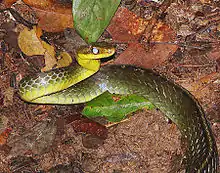Chironius carinatus
Chironius carinatus, commonly known as the machete savane or amazon whipsnake, is a very large, but slender colubrid snake. It is a nonvenomous snake, distinguished by its peaceful nature.
| machete savane (also the Amazon Whipsnake) | |
|---|---|
 | |
| Scientific classification | |
| Kingdom: | Animalia |
| Phylum: | Chordata |
| Class: | Reptilia |
| Order: | Squamata |
| Suborder: | Serpentes |
| Family: | Colubridae |
| Genus: | Chironius |
| Species: | C. carinatus |
| Binomial name | |
| Chironius carinatus | |
| Synonyms | |
Geographic range
It is endemic to the regions of Colombia, northern Brazil, Costa Rica, eastern Venezuela, northern Suriname, and Trinidad and Tobago.
Description
Chironius carinatus may grow to 3 meters (9.8 feet) in length. Their body color can range from brown to deep yellow or gold, with the tail being generally darker than the body. The belly is often a bright shade of yellow or orange. In most specimens, body scales have lightly colored centers with darker edges. A light colored stripe runs down the length of the body, fading at the tail. The dorsal scales are in 12 rows.[1]
References
- Boulenger, G.A. 1894. Catalogue of the Snakes in the British Museum (Natural History), Volume II. London. pp. 73-75.
Boos, Hans E.A. (2001). The snakes of Trinidad and Tobago. Texas A&M University Press, College Station, TX. ISBN 1-58544-116-3.